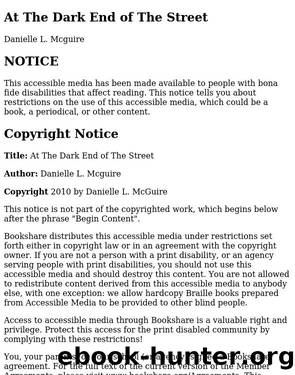At The Dark End of The Street: Black Women, Rape, and Resistance -- a New History of the Civil Rights Movement From Rosa Parks to The Rise of Black Power by Unknown

Author:Unknown
Language: eng
Format: epub
CHAPTER 7Sex and Civil Rights
onmarch 25, 1965, more than ten thousand civil rights activists and supporters spilled into downtown Montgomery, Alabama, and assembled where Jefferson Davis had once taken the oath of office as president of the Confederacy and where George Wallace had recently declared, "Segregation now, segregation tomorrow, segregation forever!" The interracial throng had passed four hard days and four harrowing nights on the lonely highway that connects Selma to the state's capital. They braved a pounding rain and slept in strangers' fields to demand voting rights and federal protection from violence.1 The normally bustling downtown was nearly empty since Governor George Wallace declared a "danger holiday for female state employees," ostensibly to protect them from the sexual threat posed by black marchers.2 The empty streets did not seem to bother the weary but jubilant crowd. "Segregation is on its deathbed in Alabama," Martin Luther King declared to the cheering audience. "The only uncertain thing," King added, "is how costly the segregationists and [Governor George] Wallace will make the funeral."3
Segregation would not die gracefully. During the Selma-to-Montgomery march, Alabama's staunchest segregationists used a kind of sexual McCarthyism in order to defame the demonstrators and to derail the new legislation that Lyndon Johnson had sent to Congress guaranteeing the right of African Americans to vote. The appeal to whites' baser instincts, and fears about sex and race, indicates how desperate the diehards had become. It also underscored the importance of sex and sexualized violence to the maintenance of white supremacy. They no longer smeared civil rights activists as mere Communists or outside agitators; now they were purely sex fiends, intent on spreading a culture of depravity throughout the country. But by 1965, these tactics were increasingly less effective.
Situated in the center of Alabama's Black Belt, an area known for its rich, inky soil and grinding poverty, Selma mirrored the Mississippi Delta in its history of near-feudal oppression of African Americans. By the 1960s, the White Citizens' Council (WCC) held dominion over the rolling pastures and cotton fields that surrounded the riverfront town.4 The mayor of Selma and the county probate judge chose its leadership; the presidents of Selma's banks sat on the council's executive committee; both editors of Selma's newspapers were "zealous adherents" to the dictates of the WCC; Selma's two radio stations and lone television outlet aired Citizens' Council propaganda as a public service; and white preachers presented their ideology as the gospel truth during Sunday services. State senator Walter Givhan, whose sprawling plantation sat in the western corner of the county, was in the WCC's pocket. He served as chairman of the Dallas County chapter until 1958 and then led the statewide Association of Alabama White Citizens' Councils for four years.5 In Selma, there was no room for opposition to the councils' rigid racial and sexual ideology, even among whites.
James Clark, the bellicose county sheriff who wore a "Never"(integrate) button pinned to his uniform, enforced white supremacy with an iron fist.
[Image: Dallas County sheriff Jim Clark uses a billy club and an electric cattle prod to push voting-rights activists away from the courthouse.
Download
This site does not store any files on its server. We only index and link to content provided by other sites. Please contact the content providers to delete copyright contents if any and email us, we'll remove relevant links or contents immediately.
| Anthropology | Archaeology |
| Philosophy | Politics & Government |
| Social Sciences | Sociology |
| Women's Studies |
The Secret History by Donna Tartt(16621)
The Social Justice Warrior Handbook by Lisa De Pasquale(11489)
Thirteen Reasons Why by Jay Asher(7788)
This Is How You Lose Her by Junot Diaz(5769)
Weapons of Math Destruction by Cathy O'Neil(5036)
Zero to One by Peter Thiel(4824)
The Myth of the Strong Leader by Archie Brown(4789)
Promise Me, Dad by Joe Biden(4447)
Beartown by Fredrik Backman(4415)
Stone's Rules by Roger Stone(4415)
How Democracies Die by Steven Levitsky & Daniel Ziblatt(4398)
The Fire Next Time by James Baldwin(4342)
100 Deadly Skills by Clint Emerson(4076)
A Higher Loyalty: Truth, Lies, and Leadership by James Comey(4032)
Rise and Kill First by Ronen Bergman(4012)
The David Icke Guide to the Global Conspiracy (and how to end it) by David Icke(3881)
The Farm by Tom Rob Smith(3872)
Secrecy World by Jake Bernstein(3782)
The Doomsday Machine by Daniel Ellsberg(3730)
